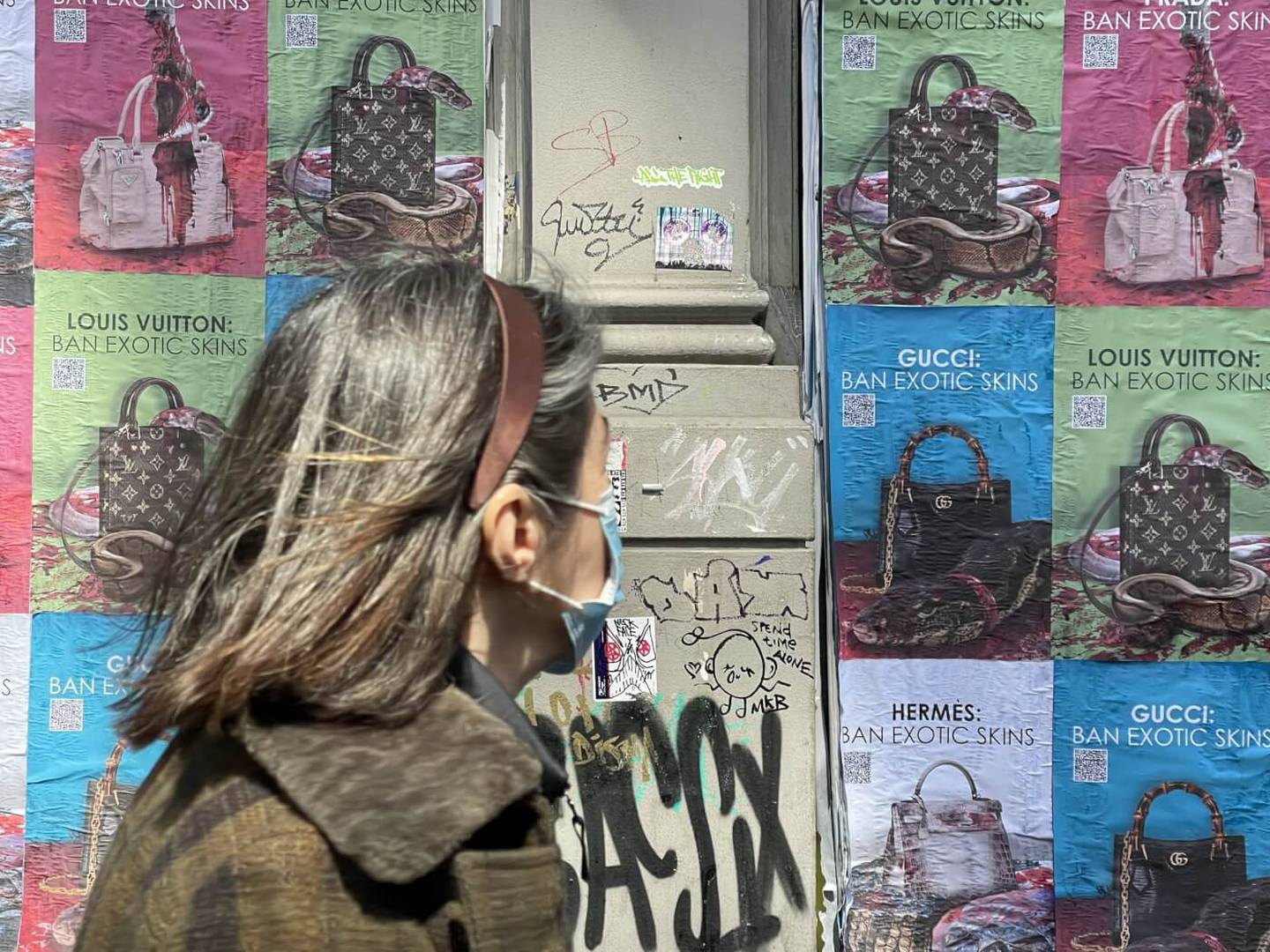
When Gucci declared fur passé in 2017, it captured a shift in attitudes that helped push the material off the shelves of most of fashion’s biggest luxury brands and retailers in the space of a few years.
Now animal rights campaigners are hoping to propel a similar movement in exotic skins, aiming to persuade big luxury brands that ostrich-skin bags and snakeskin boots are also no longer appealing to an increasingly conscious consumer base.
PETA has plastered the streets of New York with posters calling on large luxury brands to ditch the materials. It’s staged protests outside Gucci and Louis Vuitton stores, and demanded Kering, LVMH and Hermès explain why they have not switched to vegan alternatives at the luxury giants’ respective annual meetings.
But a similar domino effect to the one seen in fur has yet to take hold, even though a handful of big-name brands have moved away from the materials (notably Chanel in 2018). Instead, some brands are doubling down on the product category.
Celine will launch a line of exclusive, made-to-order crocodile skin bags in October this year, while stablemate Dior’s revamped Paris flagship has an entire section dedicated to goods made from exotic leathers. Louis Vuitton has deepened its stake in exotic skins production with two specialised leather goods workshops in France, officially opened in early April.
At its root, experts say, the issue is that for most brands ditching exotic skins is a much bigger business decision than scrapping fur.
The Bottom Line
For many brands, the decision to drop fur was made easier by the fact that the material made up a small portion of sales. That is not necessarily true for exotic skins. The category probably contributes between 10 and 100 times more to luxury brands’ revenue, according to Bernstein analyst Luca Solca.
Exotic leather goods — a seasonless category that, unlike fur, transcends specific climates — also telegraph wealth and status. That drives demand among high-net-worth customers in both emerging and developed markets. “Exotic skins are particularly important to qualify brands in the high-end,” Solca said in an email exchange with BoF. As “Dior, Louis Vuitton, Celine cultivate ambitions to elevate their standing, exotic skins are a key plank to implement this strategy.”
Thanks to its steadfast appeal among ultra-wealthy customers, the category has proven resilient during the pandemic too: exotic leather goods accounted for around 5 to 10 percent of the total leather goods market in 2021, amounting to a market value between €3 billion and €6 billion ($3.2 billion and $6.3 billion), said Federica Levato, partner and leader of EMEA luxury and fashion at Bain & Company.
Changing Tastes
Whether the financial calculus involved in using exotic skins changes may come down to consumer taste, a key factor in convincing many big brands to stop using fur. Even LVMH, the parent company of furrier Fendi and luxury’s biggest holdout on fur, has revealed plans to explore innovative, animal-free alternatives to the material with an eye on consumer demand.
That same logic should apply to exotic skins, animal rights activists say, particularly as more brands seek to court sustainably minded Gen-Z consumers by demonstrating their commitment to environmental and social responsibility.
There are signs this argument is gaining traction with some companies. Moda Operandi recently said it would stop buying virgin fur or exotic leathers, though the company may still occasionally resell vintage items containing the materials. The online luxury retailer follows other companies that have ditched exotic skins over the years, including Selfridges, Nordstrom, Mulberry and PVH, the parent company of brands including Calvin Klein and Tommy Hilfiger. Many cited commitments to sustainability as the rationale.
Those who have already banned the material “saw the writing was on the wall” for a shift in consumer sentiment, said PETA director of outreach Ashley Byrne. “The idea that [exotic skins] would be associated in any way with luxury is just absurd,” she said.
Compared to other materials, like cow leather, exotics are also more vulnerable to criticism as these animals are typically bred, captured and killed solely for their skins.
“I think most companies feel comfortable using products that are considered byproducts of the meat industry,“ said PJ Smith, fashion policy director for the Humane Society United States. “You just can’t do that with exotic skins.”
Responsibly Sourced Reptiles
Big brands have sought to stave off any backlash to exotic skins by promoting efforts to secure transparent and ethical supply chains, investing in or acquiring suppliers and working with internationally recognised standards and certifications to shore up animal welfare policies. Both Kering and LVMH have committed to achieving full traceability in their exotics supply chains by 2025.
Nonetheless, investigations as recently as last year found brutal practices at crocodile farms and reptile skinneries allegedly linked to Hermès, Kering and LVMH brands.
In response to the allegations, all three companies highlighted their animal welfare standards and commitment to full traceability in their exotics supply chains. Kering said there was no evidence that any of its brands were connected with the practices or suppliers shown in the investigation’s footage.
But full traceability — even among integrated supply chains — remains a challenge. When Chanel stopped using exotic skins in 2018, the company said the decision came down to difficulties establishing ethical supply chains.
“While Hermès may want to be able to have a crocodile purse on the boutique shelf, and be able to tell you that the animal was farmed and raised in captivity and humanely slaughtered based on [a] barcode that’s inside the purse, it’s just not going to happen,” said Bruce Weissgold, a wildlife trade expert who worked on compliance with rules governing the trade in exotic skins in the US Fish and Reptile Service for 25 years.
A Materials Revolution?
One additional pressure for brands that could change the equation is the development of lookalike plant-based alternatives to exotic skins.
Investment in next-generation materials has boomed in recent years. Start-ups developing innovative alternatives to animal fibres like leather, silk, wool, fur and exotic skins received $980 million worth of funding in 2021, more than double the amount raised in 2020, according to an analysis from the Material Innovation Initiative published in March 2022. Many brands that dropped fur still produce collections made from fake alternatives that serve as sophisticated — albeit often plastic-based — imitations of the real thing.
Luxury players have also partnered with material innovators aimed at developing leather alternatives. For instance, Hermès has teamed up with California-based MycoWorks, which is producing a high-quality leather-like material from mycelium, the root structures of mushrooms. LVMH and Kering both pointed to their work with mycelium and bio-based alternatives to real leather in response to PETA’s questions about adopting animal-free textiles at their shareholders’ meetings last month. On Wednesday, Kering was part of a $46 million funding round for lab-grown leather company VitroLabs.
But many of these innovations are still years from commercial scale and very few focus specifically on replacements for exotic skins. That makes it harder to see a large-scale shift away from the category in the near term while consumers still see allure in crocodile bags and snakeskin boots.



